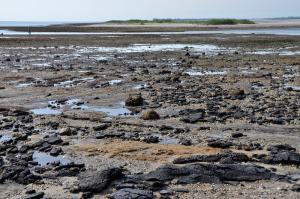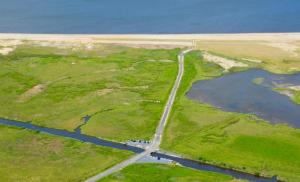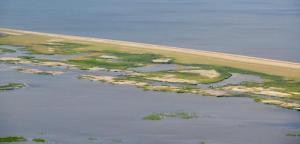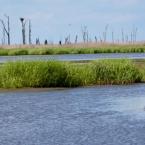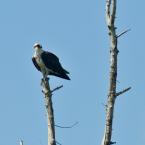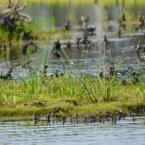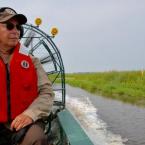Five years ago, thousands of acres of Prime Hook National Wildlife Refuge lay under water, and wide breaches in the dunes at Fowler Beach threatened to swallow up the remaining beach. Refuge officials called sections of the refuge a dead zone, but no longer.
The task of restoring more than 4,000 acres of destroyed marsh and two miles of beach was completed three years ago and is paying huge dividends.
Today, Al Rizzo, U.S. Fish & Wildlife project manager, stands on the replenished sand of Fowler Beach and is amazed how much marsh grass is growing in previously open-water areas. “The rate of recovery is mind-boggling, and after only two good growing seasons,” he says. “I love to see all this green. If we have this kind of response in two years, imagine what it will be in five years,” Rizzo said.
He used that time frame as a goal for recovery of the refuge marsh. Acres and acres of mudflats are now thriving with 3- to 5-foot marsh grasses. Nesting birds, including the refuge's very first piping plovers, and wildlife and fish are returning to the refuge.
First breach in 2006
Estuary experts painted a bleak picture of the refuge with a dying marsh and eroding beach. The project was fast-tracked with an expanded federal environmental assessment conducted in 2013. But it was only the overwhelming damage caused by Superstorm Sandy in October 2012 that sparked federal funding to rebuild the marsh and beach.
Starting in 2006, a series of storms opened several breaches along the shoreline, allowing saltwater from Delaware Bay to destroy thousands of acres of marsh as open water drowned out marsh plants.
“Ernesto started it in 2006 and Sandy finished it off in 2012,” said refuge biologist Annabella Larsen. “We basically had 4,000 acres of open water.”
Restoration work was concentrated in two areas in the northern section of the refuge known as the Unit 2 and Unit 3 impoundments, two of four units bounded to the north by Fowler Beach Road and to the south by Route 16.
Units 2 and 3 include more than 5,000 acres of the 10,144-acre refuge located near Milton.
Today, a new beach and dune system with a protected back-barrier marsh have allowed time for the impoundments to recover and return to a viable ecosystem.
“Spartina grass is making steady progress, which validates our hydrologic model,” Rizzo said.
Water flow a key to restoration
The restoration was a two-phase project involving the beach and the marsh.
During the Fowler Beach replenishment project, 1.4 million cubic yards of Delaware Bay sand were used to rebuild 2 miles of the beach. The dune was restored to a height of 9 feet with a 100- to 600-foot-wide back barrier platform between the dune line and marsh. More than 500,000 plugs of beach grass and 10,000 feet of fencing have been added to stabilize the dune and back barrier.
Early on, officials decided to restore most of the destroyed area to a saltwater marsh and end more than 30 years of maintaining a freshwater habitat, originally created to attract freshwater waterfowl. “It was not sustainable,” Rizzo said.
Twenty-five miles of restored channels have allowed more freshwater to flow into the refuge to sustain about 1,200 acres of freshwater marsh. Mud pumped out of the channels formed flats to allow marsh grass to grow. All of the water-control structures used to present saltwater intrusion were dismantled to allow for water flow.
In addition, smaller ditches not only help with water flow, but also allow for natural control of mosquitoes as fish larvae swim in the channels and feed on mosquitoes.
“There is greater diversity on the freshwater side with flow from groundwater and Prime Hook Creek,” Rizzo said.
However, with freshwater marsh come invasive phragmites. Rizzo said salt is natural control in saltwater marshes, but controls are needed to hinder growth of the plant in the freshwater marshes. He said the refuge is on schedule to spray or burn phragmites each year.
“We left things to Mother Nature, but still with a little help,” Rizzo said.
See Part 2 of this series in a future edition.
PRIME HOOK TIMELINE
1911 – Storms close outlets of Prime Hook and Slaughter creeks to Delaware Bay.
1930s – Ditches are dug to control mosquitoes and also manage water levels until the 1950s.
1963 – U.S. Fish and Wildlife Service establishes refuge; no water management occurs until 1980.
1980s – Freshwater impoundments are created for waterfowl and to control phragmites. Water-control devices eliminate all tidal flow to 4,000 acres of marshland in the refuge.
1986 – An environmental assessment finds saltwater from Delaware Bay would eventually intrude into the marshes.
1988 – First dune restoration project followed by restorations in 1992, 1998, 2006, 2008 and 2011.*
2006 – Washover into Unit 1 caused by offshore Hurricane Ernesto.
2008 – Mother’s Day nor’easter causes minor overwash that is repaired.
2009 – Major nor’easter in November opens two significant breaches into Unit 2.
2011 – Breaches widened by storm surge from Hurricane Irene; Prime Hook Road is closed for six days.
2012 – Strong waves and surge from Superstorm Sandy create the most damage to date; four significant breaches are open into Unit 2.
2013 – U.S. Fish & Wildlife Service announces ramped-up environmental study to address refuge issues.
2015 – $38 million beach-marsh restoration project gets underway.
2016 – Project is complete in the fall.
2016 – New Prime Hook Road 70-foot-long bridge opens to allow for wider channel under roadway.
2017 – Fowler Beach is named one of the five best restored beaches in the nation by the American Shore and Beach Preservation Association.
* In 2011, an overwash occurs four days after the project is completed. Officials say 80 percent of the sand needed to rebuild the dune was washed away by Hurricane Irene as it passed the coast.
PART II: Piping plover among Prime Hook success stories














